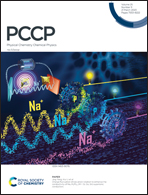A theoretical study on the photochemical generation of phenylborylene from phenyldiazidoborane†
Abstract
Organic borylenes are a kind of highly reactive species, which play important roles in a lot of reactions as vigorous intermediates. In this work, we investigated the photochemical generation mechanisms of phenylborylene (PhB) together with the side product N-phenylnitrenoiminoborane (PhNBN) from phenyldiazidoborane (PhBN6) by extrusion of dinitrogen in the two lowest electronic singlet states (S0 and S1) based on the complete active space self-consistent field (CASSCF) and its second-order perturbation (CASPT2) methods combined with time-dependent density functional theory (TD-DFT) calculations. Our results show that the reaction PhBN6 → PhB + 3N2 involves stepwise N2 extrusion three times and the azido region rearrangement. Moreover, we found that the studied photo-induced processes are kinetically feasible because the highest energy barrier is only 0.36 eV and excitation with light of wavelength 254 nm can provide enough excess energy to overcome these energy barriers. Importantly, we revealed that several conical intersections between S1 and S0 states participate and facilitate the studied photochemical processes. Our results not only clarify the experimental observations, (H. F. Bettinger, J. Am. Chem. Soc. 2006, 128, 2534), but also provide valuable insights into borylene chemistry.



 Please wait while we load your content...
Please wait while we load your content...